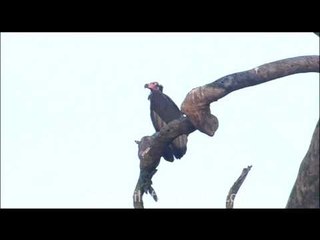
The King Vulture or Sarcoramphus papa is a large bird found in Central and South America. It is a member of the New World vulture family Cathartidae. This vulture lives predominantly in tropical lowland forests stretching from southern Mexico to northern Argentina. It is the only surviving member of the genus Sarcoramphus, although fossil members are known. Large and predominantly white, the King Vulture has gray to black ruff, flight, and tail feathers. The head and neck are bald, with the skin color varying, including yellow, orange, blue, purple, and red. The King Vulture has a very noticeable yellow fleshy caruncle on its beak. This vulture is a scavenger and it often makes the initial cut into a fresh carcass. It also displaces smaller New World vulture species from a carcass. King Vultures have been known to live for up to 30 years in captivity.Excluding the two species of condors, the King Vulture is the largest of the New World vultures. Its overall length ranges from 67--81 centimeters and its wingspan is 1.2--2 meters. Its weight ranges from 2.7--4.5 kilograms. An imposing bird, the adult King Vulture has predominantly white plumage, which has a slight rose-yellow tinge to it. In stark contrast, the wing coverts, flight feathers and tail are dark grey to black, as is the prominent thick neck ruff. The head and neck are devoid of feathers, the skin shades of red and purple on the head, vivid orange on the neck and yellow on the throat. On the head, the skin is wrinkled and folded, and there is a highly noticeable irregular golden crest attached on the cere above its orange and black bill this caruncle does not fully form until the bird's fourth year. The King Vulture has the largest skull and braincase, and strongest bill of the New World vultures. This bill has a hooked tip and a sharp cutting edge. The bird has broad wings and short, broad, and square tail.The irises of its eyes are white and bordered by bright red sclera. Unlike some New World vultures, the King Vulture lacks eyelashes. It also has gray legs and long, thick claws. The King Vulture soars for hours effortlessly, only flapping its wings infrequently. While in flight, its wings are held flat with slightly raised tips, and from a distance the vulture can appear to be headless while in flight. Its wing beats are deep and strong. Birds have been observed engaging in tandem flight on two occasions in Venezuela by naturalist Marsha Schlee, who has proposed it could be a part of courtship behaviour. Despite its size and gaudy coloration, this vulture is quite inconspicuous when it is perched in trees. While perched, it holds its head lowered and thrust forward. It is non-migratory and, unlike the Turkey, Lesser Yellow-headed and American Black Vulture, it generally lives alone or in small family groups. King Vultures have lived up to 30 years in captivity, though their lifespan in the wild is unknown. This vulture uses urohidrosis, defecating on its legs, to lower its body temperature. Despite its bill and large size, it is relatively unaggressive at a kill. The King Vulture lacks a voice box, although it can make low croaking noises and wheezing sounds in courtship, and bill-snapping noises when threatened. Its only natural predators are snakes, which will prey upon the vulture's eggs and young and large cats such as jaguars, which may surprise and kill an adult vulture at a carcass.This bird is a species of Least Concern to the IUCN, with an estimated range of 14 million km2 and between 10,000 and 100,000 wild individuals. However, there is evidence that suggests a decline in population, though it is not significant enough to cause it to be listed. This decline is due primarily to habitat destruction and poaching. Although distinctive, its habit of perching in tall trees and flying at altitude render it difficult to monitor.Source: WikipediaThis footage is part of the professionally-shot broadcast stock footage archive of Wilderness Films India Ltd., the largest collection of imagery from South Asia. The Wilderness Films India collection comprises of thousands of hours of high quality broadcast imagery, mostly shot on HDCAM 1080i High Definition, HDV and XDCAM. Write to us for licensing this footage on a broadcast format, for use in your production! We are happy to be commissioned to film for you or else provide you with broadcast crewing and production solutions across South Asia. We pride ourselves in bringing the best of India and South Asia to the world... Reach us at wfi @ vsnl.com and admin@wildfilmsindia.com.
King Vulture on a bare tree
0 Comments